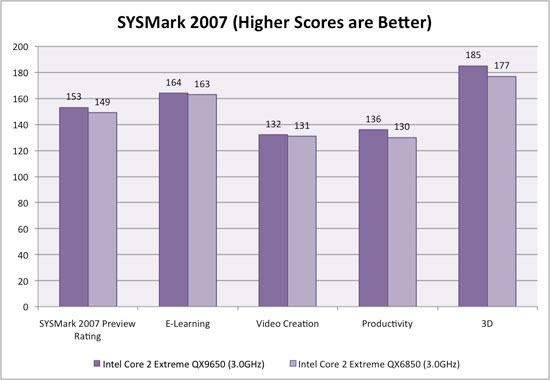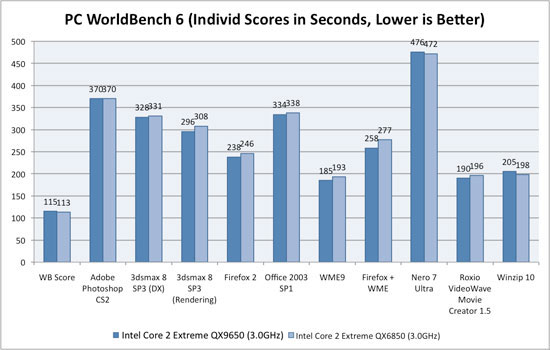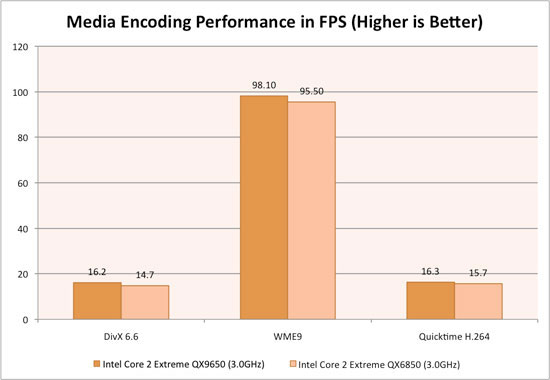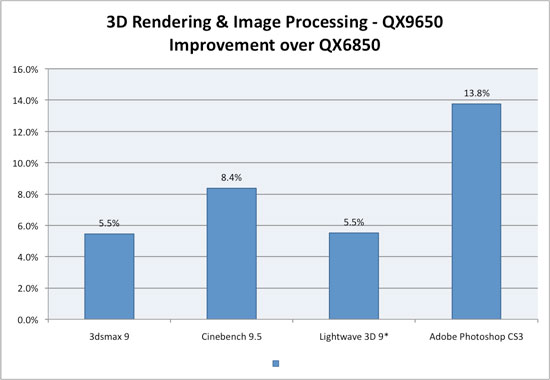Intel Core 2 Extreme QX9650 - Penryn Ticks Ahead
by Anand Lal Shimpi on October 29, 2007 12:13 AM EST- Posted in
- CPUs
Everything You Need to Know: Yorkfield vs. Kentsfield
The big question is: how does Yorkfield stack up to Kentsfield, the current 65nm quad-core part from Intel? Thankfully, the QX9650 runs at the same clock speed/FSB as the Kentsfield-based QX6850 making our job a little easier. We put these two bad boys up against one another and waited for the smoke to clear.

As we saw in our initial Penryn preview, the general application suite tests just don't show any real improvements of Penryn over Conroe. SYSMark 2007's overall performance went up by 2.6% but that's far from significant. If you look at the individual tests however, you'll see that the 3D benchmarks went up by 4.5% and the productivity suite went up by a similar 4.6% margin. The improvements in the 3D suite are expected, given the Radix-16 and Super Shuffle Engine enhancements to the Penryn core. The productivity suite most likely benefits from the Radix-16 divider as well as the larger cache. Overall the performance boost just isn't that significant, but given that Penryn is expected to arrive without a price premium, any performance improvement is better than nothing.

We see the same situation under PC WorldBench 6: the overall performance boost of Penryn over Conroe is basically nil. Digging deeper we see performance increases on the order of 4 - 7% if we look at the individual 3D rendering or media encoding tests.
Next up we've got our encoding tests, and given what we've already seen, we should expect some nice gains here:

And nice gains we do get. The clock-for-clock improvement under DivX 6.6 is a nice and round 10%, although curiously enough we get a meager 3% from our Windows Media Encoder test. Our QuickTime H.264 test shows a more average 4% performance increase, similar to our WME test.
Professional 3D rendering and image manipulation are also areas where we expect to see reasonably high gains from Penryn. Our 3dsmax, Cinebench and Lightwave tests remain unchanged from previous articles. The CS3 benchmark is the same Retouch Artists test we've used in previous CPU reviews. In order to avoid having a graph scale that ranged from zero to the thousands we simply included percentage improvements here rather than actual numbers (e.g. 3dsmax scores are single digits while Cinebench scores are 4 digits):

As expected, we're seeing reasonable gains here. 3dsmax shows a 5% increase, Cinebench 8%, Lightwave 6% and Photoshop CS3 has a healthy 10% performance boost in store for us. Without a doubt encoding and 3D/image manipulation are the real strengths of Intel's Penryn architecture.
The final Penryn test is all about 3D gaming and thankfully we have a number of new titles to play with. All of our benchmarks were run at 1024 x 768 to avoid being GPU bound and with high quality settings (the exceptions being Crysis and World in Conflict which both used Medium quality defaults).

* Denotes performance in minutes, lower is better
Penryn's gaming performance is really all over the place. Titles like Oblivion and Bioshock see absolutely no performance increase, while Crysis gives us a mild 3.7% performance boost. Half-Life 2: Episode Two and Unreal Tournament 3 enjoy a 5.1% and 6.4% increase respectively, while World in Conflict and Quake Wars are both at around 9%.
If anything the gamut of gaming benchmarks sums up Penryn's performance improvement over Conroe quite well: it really varies from nothing to something.










16 Comments
View All Comments
Canadian87 - Monday, October 29, 2007 - link
I'd like to point out that someone must have been tired when writing this. The graphs here on page 4 say "QX6950" VS "QX6850", simple reversal of the numbers, but I'd like to correct it for those that might be confused, took me a moment to figure out which was which myself the "QX6950" is ment to be the "QX9650", and obviously the "QX6850" is the correct naming.GL HF.
GlassHouse69 - Monday, October 29, 2007 - link
ew.intel again ftw. blech. They made a great chip. power usage is fantastic. One could get even lower total wattages (by far) if they concentrated on doing so. a quad core that can be cooled near silently. neat :)
sprockkets - Monday, October 29, 2007 - link
Just a question, what was the difference from Core to Core 2? All I could ever fine was cache size was increased.Now that I'm thinking about it, why not the name Quadro? Oh, nVidia ownz it.
defter - Monday, October 29, 2007 - link
Core Duo (Yonah) was based on Pentium M.Core2 (Conroe) is a new architecture.
sprockkets - Monday, October 29, 2007 - link
actually i found a comparison page about it, and core 2 isn't that much different from core. Yes, it updated a lot and gave improved performance. No, it is not a completely new architecture from PM, but you can say a big difference from the P4.http://www.anandtech.com/showdoc.aspx?i=2808&p...">http://www.anandtech.com/showdoc.aspx?i=2808&p...
sprockkets - Monday, October 29, 2007 - link
On page 9 I believe you are grabbing some old benchmarks, old in the sense of your previous articles. I believe I pointed this out to you as a mistake, and now it is here in the bar graph. Again, how is it that the 2.33ghz C2D outperforms the 3ghz one?